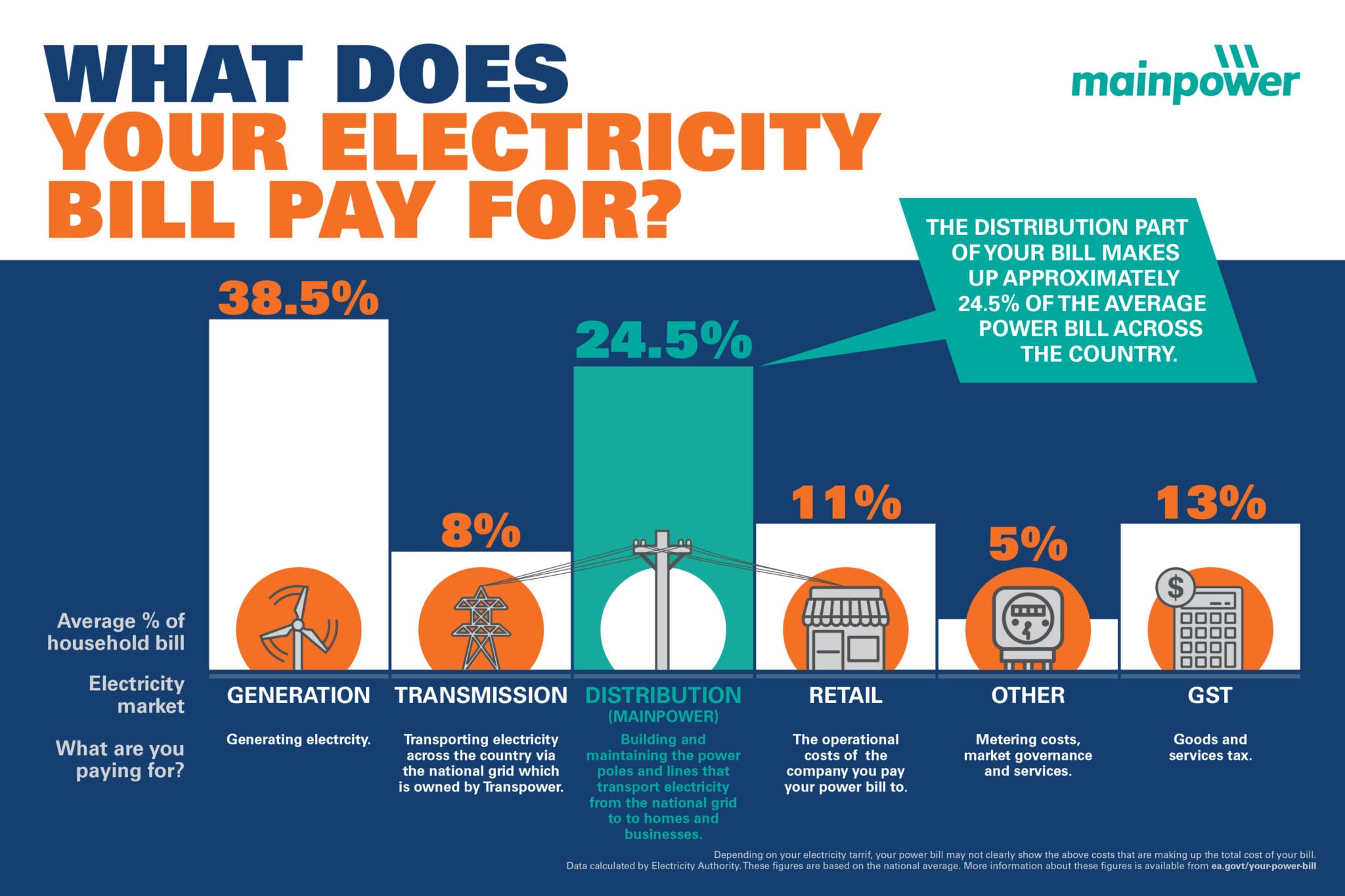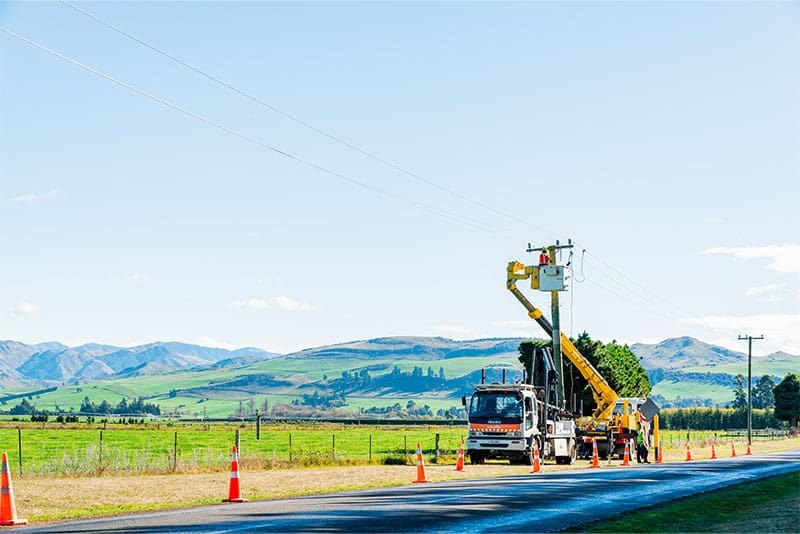This page provides information for our residential and business customers on network pricing.
MainPower provides distribution line services (poles and wires that deliver electricity to homes and businesses) to a population of over 80,000 people in the North Canterbury and Kaikōura region. Approximately 76% of our customer base is residential, with the majority of the remaining being small commercial, farming, or irrigation customers.
We consult with our customers on an annual basis to gauge their general level of satisfaction with the distribution services we provide, as well as on price and quality expectations.
MainPower generally performs well in terms of both reliability and quality of supply. Our customers also tell us they would definitely not be willing to accept poorer levels of power quality and reliability in exchange for a lower price or discount.
We’re here to help. Get in touch if you need help. Or, check out our FAQs.

Network pricing
MainPower does not bill customers directly for distribution lines services. Instead, we charge electricity retailers for the delivery of electricity over the MainPower network.
Electricity retailers determine how to allocate this cost, together with energy, metering and other retail costs, when setting the retail prices that appear on customers’ electricity bills. According to the Electricity Authority website, around 27% of your electricity bill goes to paying costs involved in the local distribution of electricity.


Need more information?
Please submit a request through our Get in Touch form if you’d like a member of our team to answer any further questions.
From 1 April 2025, MainPower’s network charges will be increasing. For each of the residential customer groups this will result in an increase of around 18.5% (around $19 per month) on the transmission and distribution portion of your power bill.
The increase in MainPower’s charges is due to rising operational costs and the work that is required to ensure that MainPower can meet the increased demand for electricity due to population growth and adoption of new technologies such as electric vehicles, industrial electrification, and new appliances.
It is also due to the national grid operator, Transpower, increasing its MainPower transmission fees to $13.5m for the 2025/26 financial year (prior year $11.09m). MainPower is required by the Commerce Commission to pass these transmission charges through to consumers in our pricing. The Electricity Authority requires that these transmission charges be passed through as a fixed daily charge where possible.
This will depend on the pricing plan you are on and how your electricity retailer chooses to bundle the pricing on your electricity bill. The impact will vary depending on your individual circumstances and how much electricity you consume.
While MainPower’s costs will be included in your electricity bill, it is not always obvious which part of your bill we are responsible for as retailers may choose to package your pricing differently to our tariff. MainPower does not have any control over the amount your retailer charges you or how they display it on your bill.
The average residential customer is likely to experience an increase in their network charges of approximately 18.5% (around $19 per month). This increase only applies to the transmission and distribution portion of the electricity bill sent by your chosen electricity retailer, not the overall bill.
Please contact your retailer if you wish to discuss pricing plans or visit the Powerswitch website to make sure you are on the most suitable plan for you.
From 1 April 2025, we have reduced the number of residential tariffs available. This will simplify our pricing and allow MainPower to be more flexible with our pricing in the future.
Customers who allow MainPower to control their hot water cylinder will continue to receive a discount to recognise the benefit the customer is providing. However, this is now accounted for as an “optional additions” to the two remaining tariffs. Likewise, customers who were previously on the Night Only tariff will also be assigned to the Night Optional addition.
From 1 April 2025.
This increase is due to a rise in the operational costs of MainPower to build and maintain the network.
It is also due to the national grid operator, Transpower, increasing its MainPower transmission fees to $13.5m for the 2025/26 financial year (prior year $11.09m). MainPower is required by the Commerce Commission to pass these transmission charges through to consumers in our pricing. The Electricity Authority requires that these transmission charges be passed through as a fixed daily charge where possible.
MainPower continues to re-invest in the network as it continues to grow. More than 1,500 new customers are forecast to connect to the network in the coming year. In addition, a number of businesses are electrifying their operations and customers are adopting new technologies, such as electric vehicles.
The national grid operator, Transpower, is increasing its MainPower transmission fees to $13.5m for the 2025/26 financial year (prior year $11.09m). MainPower is required by the Commerce Commission to pass these transmission charges through to consumers in our pricing. The Electricity Authority requires that these transmission charges be passed through as a fixed daily charge where possible.
MainPower pays a rebate to Qualifying Customers – that is, customers connected to the MainPower distribution network (excluding customers on a builders temporary supply). Customers connected to the former Kaiapoi Electricity network are not Qualifying Customers.
The monthly rebate paid to Qualifying Customers is applied as a percentage discount off the fixed charge before we pass it on to the retailer. Some retailers choose not to show this discount on their invoices. Customers connected to the former Kaiapoi Electricity network will have a customer discount applied to their fixed charge equivalent to the MainPower rebate.
From 1 April 2025, the rebate and discount are set at 26% off the fixed daily charge for residential customers and 13% off the fixed daily charge for non-residential customers. The rebate is deducted off the charge and not passed onto the customer in the form of a cheque or refund paid directly by MainPower.
To reduce the impact of the increased Transpower charges and increased operating costs for MainPower, we have increased our rebate from $5m in 2024/25 to $10m in 2025/26.
The rebate is applied as a deduction from the fixed daily charge. The prices published in our network pricing document have already taken into consideration the rebate we offer to our customers in the coming year.
Customers connected to the former Kaiapoi Electricity network receive a discount applied to their fixed charge equivalent to the MainPower rebate.
All eligible customers receive the MainPower rebate. However, some retailers choose not to show this discount on their invoices.
The Government decided to phase out low-user fixed charges over five years from 2022 to 2027.
The Electricity (Low Fixed Charge Tariff Option for Domestic Consumers) Regulations 2004 (known as “the low fixed charge regulations”) were introduced in 2004 partly to reduce the impact of high fixed charges on customers with low consumption and fixed incomes and to encourage energy conservation. Under the regulation, MainPower, as the lines company for North Canterbury, was only able to charge customers eligible for the low-user tariff 15 cents per day as a fixed charge. The electricity retailer was able to charge an additional 15 cents per day.
As time has passed, the low fixed charge regulations have had some unintended consequences. The regulations have had the effect of benefitting many customers who do not need assistance – for example, small households in modern, well-insulated houses – at the expense of larger families in poorly insulated homes.
The regulations also benefitted people who could afford to install solar PV panels to reduce their electricity bills at the expense of other customers who used more electricity.
The phasing out means MainPower will only be able to gradually increase the low fixed charge by 15 cents per day each year between 1 April 2022 and 31 March 2027. The current low user fixed charge is 75 cents per day (before discounts or rebate). The electricity retailers are subject to the same requirements.
Support that may be available and further information can be found at the following websites:
Your electricity bill is made up of several elements, one of which is the cost of delivering electricity to your property via MainPower’s network, a process known as distribution. The distribution charge accounts for around 27% of your total electricity bill and is made up of a combination of fixed and variable charges.
MainPower is also charged by Transpower for the costs of transmitting electricity from the electricity generators through the national grid to the MainPower network. We are required by the Commerce Commission to pass these charges through to consumers in our pricing. Transmission charges account for approximately 10% of your total electricity bill.
To find out more about what makes up your power bill, click here.
The Commerce Commission decides how much money we can earn, making sure it covers our network’s operating and maintenance costs. MainPower, as a trust-owned electricity distribution business, chooses to follow the Commerce Commission directions.
The Electricity Authority manages how this money is shared among customers by setting guidelines on pricing structures.
No. By regulation, costs related to the Mt Cass Wind Farm development cannot be recovered through network charges.
We’re here to help
If you need some assistance or advice, please get in touch with our team.